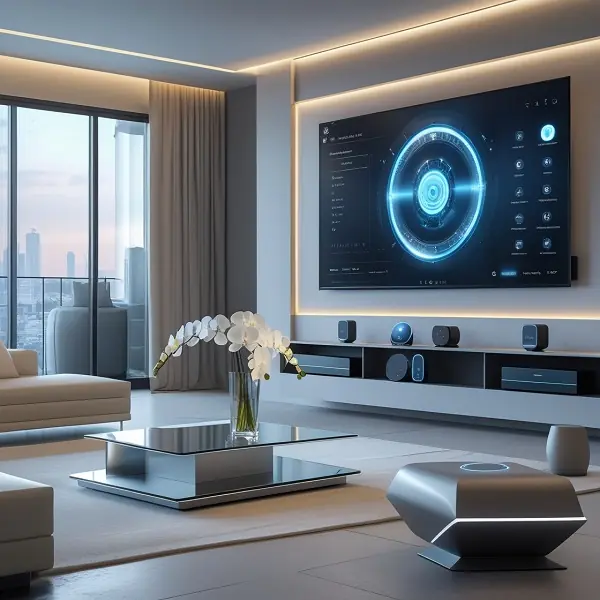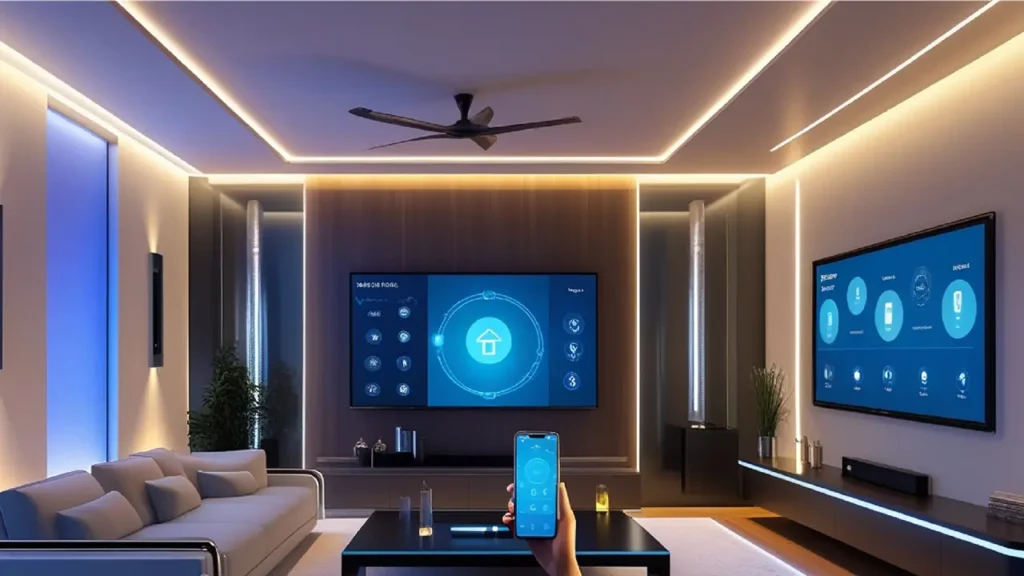What is a Smart Home?
A smart home is a residence connected with various smart devices. These devices allow homeowners to monitor, control, and automate systems in their homes. This includes appliances, lighting, security, heating/cooling, entertainment, and even health-related devices.
Smart home technology works when connected to the internet and smart home devices are controlled remotely or programmed to operate autonomously, typically through smartphones, voice assistants, or specialized hubs.
Smart homes provide more than just basic control over appliances. They offer integration between devices. The systems work together to improve your daily living experience.
Your smart home technology automatically adjusts the light of your home to the time of day, makes your thermostat learns your comfort preferences, and helps your security system to recognize your face to unlock the door when you arrive home.
Key Features of Smart Home Tech
A smart home uses sensors, actuators, and communication technologies to monitor and control elements such as light, temperature, humidity, security systems, and even health metrics. It enables remote access and control through apps from your mobile, making your home a dynamic, adaptable environment.
Core Technologies
The technologies behind smart homes are based on Internet of Things (IoT) principles. IoT refers to the network of devices that communicate with each other through the internet. Smart devices can exchange data, learn patterns, and execute tasks automatically, creating a more efficient, intuitive living environment.
KNX Protocol
The KNX protocol is a globally recognized and standardized communication protocol designed to ensure compatibility between different devices and systems in the realm of smart homes and building automation. KNX enables a high level of interoperability between devices to create a fully integrated and personalized smart home experience. This protocol offers a robust, flexible, and open communication standard.
How Does Smart Home Technology Work?
Smart home technology works by linking various internet-connected devices into a cohesive network. This system allows for remote control and automation. These devices communicate through wireless technologies, and their functions are coordinated by hubs or apps.

Here’s a more in-depth breakdown of the workings:
Devices & Sensors
Smart Appliances: These include refrigerators, washing machines, dishwasher, robot vacuum, thermostat, ovens, coffee makers, and security cameras. These devices require a Wi-Fi connection to connect with the mobile app or web portal, enabling remote control from anywhere.
For example, a smart fridge can keep track of the contents, recommend recipes, or notify you when something is running low.
Sensors: Sensors form the backbone of many smart home functions. For instance, motion sensors can detect activity and trigger lights or alarms, while temperature sensors in smart thermostats adjust heating or cooling based on your preferences.
These sensors detect variations in infrared energy, such as body heat, in their environment. Motion sensors are commonly used in smart lighting systems, security cameras, and automated door locks to improve both security and energy efficiency in the home.
Smart air conditioner, equipped with both cooling and heating functions, can perform a variety of tasks such as fresh air purification, haze removal, and formaldehyde elimination. By integrating sensors for carbon dioxide, PM2.5, formaldehyde, temperature and humidity, refrigerant leakage, and human presence detection, it enables automatic control and enhances air quality.
Smart Lights: Smart lights are controlled through various interfaces, such as mobile apps, voice commands, and even automated schedules. Users can create personalized lighting scenes for different activities, like reading, watching movies, or hosting a dinner party. With simple voice commands, lights can be dimmed, brightened, or set to a specific color, offering unparalleled convenience.
These bulbs are not just energy-efficient; they are highly customizable, allowing users to adjust the color, brightness, and temperature of the light to suit their needs and preferences.
Connectivity
There are four mainstream wireless technologies currently used in smart home: Bluetooth,
WiFi, Z-Wave, Zig-bee. The most competitive technology is WiFi technology and Zig-bee.
Bluetooth & BLE: Bluetooth and BLE (Bluetooth Low Energy) are works with devices that need close-range communication. BLE is particularly used for low-power applications and for devices that need occasional communication. They are common in smart locks, headphones, and fitness trackers.
BLE is specifically designed for Internet of Things (IoT) applications. Its features, such as limited power consumption and efficient memory usage, address the unique constraints of IoT devices. BLE enables these devices to function for long periods without the need for frequent battery replacements or recharging, making it an ideal solution for IoT environments.
The low power consumption and optimized data transmission mechanism of Bluetooth Low Energy allow it to operate on minimal power, making it an ideal choice for battery-operated devices. This efficiency extends battery life, reducing the need for frequent replacements or recharging, and enhancing the overall performance of IoT applications.
Wi-Fi: Many smart home devices, especially those with high data requirements like security cameras or smart speakers, use Wi-Fi to communicate. Wi-Fi enables easy connection to the internet and can support devices with higher bandwidth requirements.
Wi-Fi enables smart devices to communicate with one another, forming an interconnected network. For instance, if a break-in is detected, your smart home security system can send an alert to your smart speakers, ensuring you’re immediately informed of the situation. This seamless integration allows for real-time notifications and enhanced control over your connected home.
Zigbee & Z-Wave: Zigbee is an open-source, low-power wireless communication technology that operates within the 2.4GHz frequency band. It is designed for short-range, low-data-rate applications, making it ideal for connecting devices in home automation, industrial control, and other IoT systems.
Z-Wave is another widely used wireless technology in home automation systems. Operating on the 908MHz frequency band, it is designed for reliable, low-power communication between devices. Z-Wave typically has a range of 30 to 100 feet, depending on environmental factors such as walls and interference.
These are mesh network protocols designed for low-power devices. They allow devices to communicate over longer distances and bypass common issues like Wi-Fi congestion. These protocols are often used for sensors, locks, and smart bulbs, creating a network where devices communicate with each other directly, extending their range.
Control and Automation
Mobile Apps: Each smart device usually comes with its own app. These apps allow you to control individual devices from anywhere. For instance, the Nest app allows users to monitor and control their thermostat settings, while the Ring app lets you view live video footage from your doorbell camera.
Voice Assistants: Voice assistants allow for hands-free control of your smart home devices. Amazon Alexa, Google Assistant, and Apple Siri – are good examples of voice assistants. You can issue commands like “Alexa, turn off the kitchen lights” or “Hey Google, adjust the thermostat to 72 degrees,” which integrates voice recognition with the broader smart home ecosystem.
Automation: Automation is the real magic of smart homes. For example, a “Good Morning” scene might turn on your lights, set the temperature, and start your coffee machine as you wake up. Routines or schedules allow devices to operate without user input. You could program your lights to turn on at sunset or set your thermostat to lower the temperature while you’re at work.
Cloud Services & Data
Cloud Computing: Many smart home devices rely on cloud-based services for processing. For example, your thermostat might learn your heating/cooling preferences over time by sending data to the cloud and analyzing your past behavior. This allows the device to make intelligent adjustments to the temperature automatically.
Smart homes generate large volumes of data from various connected devices. Cloud computing provides powerful storage solutions that ensure this data is securely stored and easily accessible. By leveraging cloud infrastructure, smart home systems can manage and analyze data efficiently, offering real-time insights and enabling seamless integration across devices.
Data Analytics: Devices like smart meters track your energy usage and send reports to the cloud, where the data is analyzed to suggest energy-saving strategies. Similarly, smart cameras use cloud storage to save recorded footage, often allowing you to review events remotely.
AI/ML Integration: Many modern smart home devices incorporate Artificial Intelligence (AI) and Machine Learning (ML) to improve their functionality over time.
These ML and AI-driven systems have the ability to process and analyze large volumes of data from various sensors and devices. By learning from user behavior, they can make intelligent decisions that enhance comfort, energy efficiency, and security.
Through continuous learning and adaptation, these systems optimize the performance of smart home technologies, adjusting settings such as temperature, lighting, and security protocols based on user preferences and real-time conditions, providing a more personalized and efficient living environment.
Integration
Ecosystem Integration: One of the greatest advantages of smart homes is the integration between various devices. For example, if you set your smart lock to unlock when it detects your phone’s Bluetooth, the system can also notify you when the door is unlocked and activate the security cameras.
Cross-Platform Integration: Devices from different manufacturers often work together. If you use Amazon Alexa, you can connect a wide range of compatible devices, like Philips Hue lights or Ring security cameras, and control them all through the Alexa app or voice commands. Similarly, Google Home supports various third-party brands.
IFTTT (If This Then That): Platforms like IFTTT allow for more advanced integration and automation between devices from different brands. For example, you can set up a rule that says, “If my security camera detects motion, turn on the lights and send a notification to my phone.”
It is available on both iOS and Android platforms and can be seamlessly integrated with a wide range of popular devices, including Ring, Blink, Hue, WeMo, and many others. This compatibility allows users to easily control and monitor their smart home devices from a single, convenient interface.
Pros and Cons of a Smart Home
Pros of Smart Home Technology

Convenience
Remote Access: One of the biggest selling points of a smart home is the ability to manage and control various devices from anywhere. You can check if you left the lights on or adjust the thermostat while you’re on vacation. Some devices even allow you to control them remotely via apps, providing an added layer of control over your environment.
Hands-Free Operation: Voice control takes convenience to the next level. You can control your home just by speaking commands. No more getting up to turn off lights or adjust the temperature—simply ask your voice assistant to handle it for you.
Energy Efficiency
Optimized Heating/Cooling: Smart thermostats don’t just allow you to adjust the temperature remotely—they also learn your schedule and adjust the temperature accordingly. If you’re out of the house, it can automatically lower the heat or turn off the air conditioning, reducing unnecessary energy consumption and lowering utility bills.
Energy Usage Monitoring: Some smart devices, like smart plugs or smart meters, track your energy consumption and provide insights to help you optimize usage. You can see which devices are consuming the most energy and make adjustments accordingly, and save money.
Eco-Friendly Solutions: Many smart home devices are designed with energy efficiency in mind, reducing overall consumption and lowering your carbon footprint.
Security
24/7 Monitoring: Smart cameras and doorbell cameras, like Ring, allow you to monitor your home in real-time from anywhere in the world. These devices send you notifications whenever motion is detected or when a visitor rings the doorbell. Many models include two-way audio, enabling you to speak to visitors remotely.
Enhanced Access Control: With smart locks, you can lock or unlock your doors remotely, allowing you to give access to trusted people when you’re not home. You can also track when doors are locked or unlocked and create temporary codes for service people or guests.
Real-Time Alerts: Smart security systems can send instant alerts if they detect unusual activity, such as a door being opened unexpectedly or a camera detecting motion. These notifications can be sent to your phone, allowing for immediate action.
Customization and Automation
Customized Routines: Imagine waking up in the morning and having your house automatically adjust to your needs: lights turn on, blinds open, coffee brews, and the thermostat adjusts to your preferred temperature. Smart home devices can automate daily tasks to fit your lifestyle and habits.
Time-Based Settings: Automating your home to respond to specific times of day or events can save you both time and energy. For instance, your lights can be set to turn off at bedtime, and your smart irrigation system can water your plants at optimal times.
Accessibility
Ease of Use for Seniors: For elderly individuals, smart homes offer the convenience of controlling systems remotely, whether it’s adjusting the thermostat or calling for help via a smart speaker. Voice assistants can be used to help with daily tasks, reducing reliance on physical mobility.
Assistive Technologies: Voice-controlled lights, smart locks, and temperature control allow people with disabilities to manage their environment without needing physical intervention. This improves autonomy and quality of life.
Increased Property Value
Market Appeal: With the increasing demand for smart homes, potential buyers often look for properties with integrated smart technologies. These homes typically command a higher price due to the added convenience, energy efficiency, and security features.
Tech-Savvy Buyers: As more tech-savvy buyers enter the housing market, homes equipped with smart devices become more appealing. Features like home automation systems, energy-efficient appliances, and integrated security systems can significantly increase a home’s value.
Cons of Smart Home Technology
Cost
High Upfront Costs: While there are entry-level options, outfitting an entire home with smart technology can be expensive. Smart thermostats, cameras, lights, and appliances can add up, particularly when buying top-tier brands.
Installation Costs: For more complex devices or setups (like integrated home theaters or security systems), you may need professional installation, which can further increase the cost.
Complexity
Technical Setup: For individuals not familiar with technology, setting up a smart home can be intimidating. Configuring apps, pairing devices, and ensuring everything works together can require time and effort.
Ongoing Maintenance: Smart home devices often require software and firmware updates to stay secure and functional. Keeping track of these updates can become a hassle, especially if you have a lot of devices.
Security Risks
Vulnerability to Hacking: Since smart home devices are connected to the internet, they are vulnerable to cyberattacks. Hackers can potentially access your home network and control devices like cameras, locks, or thermostats. Ensuring proper network security (e.g., encryption, two-factor authentication) is essential to protect your home.
Data Privacy Concerns: Many smart devices collect user data (such as daily routines, preferences, and activities). This data is often stored in the cloud or shared with third-party companies. Privacy concerns arise when this data is exposed, mishandled, or used for targeted advertising.
Compatibility Issues
Fragmented Ecosystems: There are several competing smart home ecosystems. Devices from different brands may not always work seamlessly together, and you may need specific bridges, hubs, or apps to integrate them.
Different Protocols: Some devices rely on Zigbee, Z-Wave, or proprietary communication methods, which might require a specific hub or gateway to work together. Ensuring that your devices use compatible technologies is important for smooth integration.
Reliability
Dependence on Internet Connectivity: If your home’s internet connection is slow, unstable, or down, many smart devices will lose functionality. Devices that rely on cloud services or remote control via apps may stop working properly, rendering your smart home less responsive.
Device Failures: Just like any other electronic device, smart home gadgets can fail. Whether it’s a malfunctioning sensor, an app crash, or a smart light that won’t connect, these issues can be frustrating. Without backup systems, you may find it difficult to manually control these functions.
Privacy Concerns
Constant Monitoring: Many smart devices, especially security cameras and voice assistants, are designed to listen or monitor constantly. While this improves functionality, it raises concerns over surveillance. Unauthorized data collection could lead to breaches of personal privacy.
Data Sharing: Many smart devices collect and share personal information with third parties, including manufacturers and advertisers. Even if this data is anonymized, it could still be used in ways that you may not agree with or understand fully.




